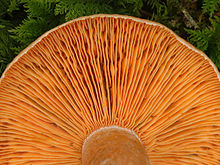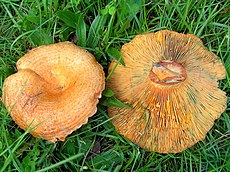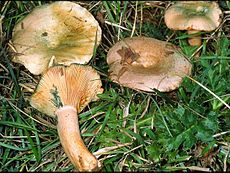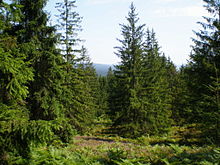Fichten-Reizker
| Fichten-Reizker | ||||||||||||
|---|---|---|---|---|---|---|---|---|---|---|---|---|
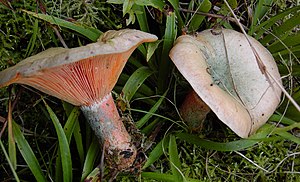
Two older fruiting bodies of the spruce irritant |
||||||||||||
| Systematics | ||||||||||||
|
||||||||||||
| Scientific name | ||||||||||||
| Lactarius deterrimus | ||||||||||||
| Gröger |
The spruce Reizker ( Lactarius deterrimus ) is a fungal art from the family of Täublingsverwandten (Russulaceae). The medium-sized Milchling has a more or less orange-colored hat that gets green spots with age or when injured. Its orange milk turns wine red within 30 minutes. The Milchling is a mycorrhizal fungus that is strictly bound to the spruce . The fruiting bodies appear between the end of June and November, preferably in spruce forests. The spruce irritant is widespread in Europe and is one of the most common types of fungus in Germany and Austria.
Until the middle of the last century, all reddish-milky irritants were grouped together and referred to as blood irritants. That is why the name spruce blood irritant is often used. Like all representatives of the Reizker ( Deliciosi section ), the Spruce Reizker also belongs to the edible mushrooms, but it often tastes slightly bitter. That is why the person who first described it, Frieder Gröger, assigned it the Latin species attribute “ deterrimus ”. The superlative of “dēterior” (= inferior) means something like “the worst, the inferior”. Gröger justified his choice of name with the bitter aftertaste and because the spruce irritant can hardly be used as an edible mushroom due to the strong maggot infestation.
features
Macroscopic features
The hat is 3 to 10 centimeters, rarely up to 12 centimeters wide and more or less circular. At the beginning it is arched and rolled up at the edge, which is at most slightly felt, but soon depressed in the middle and later deepened in a flat, funnel-shaped manner. The hat skin is bare, greasy in damp weather and still slightly shiny even when dry. The hat is orange-red to orange-brownish in color, sometimes zoned darker towards the edge and fades mainly yellowish-brown. In old age or after cold and frost, it turns more or less dirty greenish or green-spotted.
The tightly standing, arched lamellas are pale orange to pale ocher in color and either attach to the stem or run down a little. They are brittle and mixed in with shorter intermediate lamellae and partially forked near the handle. In old age or when injured, they first develop dark red, then gray-green spots. The spore powder is pale ocher.
The usually long cylindrical stem is orange-flesh red in color. It is 4 to 8 (rarely 10) centimeters long, 1 to 1.5 centimeters wide and hardly pitted or blotchy. At the base it is often somewhat thickened or puffed up and soon becomes hollow on the inside. There is usually a whitish, frosted ring-shaped zone at the base of the lamellae.
The milk is carrot red at first and turns wine red within 10 to 30 minutes. The meat, which is usually extremely bad, is brittle and pale yellow in color. When cut or at break points, it turns carrot-red, then wine-red and, within hours, dirty green, like milk. The fruit body smells tart, fruity and tastes mild at first, but then slightly resinous and bitter and almost spicy or somewhat astringent.
Microscopic features
The rounded to broadly elliptical spores are 7.5–10 µm long and 6–7.6 µm wide. The ornament grows up to 0.5 µm high and consists mainly of warts and short, fairly wide ridges, which are connected to one another by a few finer lines to form a very incomplete network. The hilly spot , a clearly delimited zone above the apiculus , is only weakly amyloid . The 4-spore basidia measure 45–60 × 9.5–12 µm. They are more or less cylindrical to almost club-like and often contain an oil droplet or have a granular content. The sterigms are 4.5–5.5 µm long. The thin-walled pleuromacrocystids are sparse, but often present in the vicinity of the lamellar edge. They protrude somewhat and are 45–65 µm long and 5–8 µm wide. They are only sometimes smaller in the vicinity of the blade edge. They are almost spindle-shaped and often narrowed or constricted like a string of pearls at the tip. The content is often fine-grained. Pseudocystidia are abundant. They are 4–6 µm wide and sometimes protrude somewhat, but are often shorter than the basidiols . Basidioles are called basidia that are still at an early stage of development. The basidiols are cylindrical to convoluted and, like sap hyphae (laticifers), have an ocher-yellow content. However, near the tip they are almost translucent. The lamellar cutting edge is usually sterile and has only a few or quite a few cheilomacrocystids. The thin-walled cheiloleptocystidia are 15–25 µm long and 5–10 µm wide. They are almost club-shaped or irregularly shaped and translucent. A fine-grained content can often be seen inside. The also thin-walled cheilomacrocystids are 25–50 µm long and 6–8 µm wide. They are slightly spindle-shaped and often have a pearl-shaped tip, their contents are hyaline or granular. Juice hyphae are abundant and noticeable, their contents are ocher yellow. The hat skin is an ixocutis . In this type of hat skin, the hyphae of the hat cover layer are bound into a gelatinous matrix that can swell up very slimy when wet.
Species delimitation
- The also quite common Edel-Reizker looks very similar. The main difference between the spruce and spruce pebbles is that, due to the discoloration of the milk, its flesh turns red within 10 minutes and dark wine red within 30 minutes. In the case of the Edelreizker, the milk stays orange or turns reddish within 30 minutes. In addition, the milk tastes mild with the Edelreizker and clearly bitter with the Spruce Reizker. In spruce irritants, the hat changes its color to a clear greenish color with age or when injured and it occurs exclusively under spruce trees, while noble irritants are found under pines.
- The very rare chip green pine irritant is even more similar . Its milk, which is also orange when it emerges, turns wine-red within 5 to 8 minutes. Its hat is almost completely greenish in color on older fruiting bodies. He is also a pine companion.
- The Scandinavian spruce irritant , a boreal to subalpine species that is almost non-existent in Germany , is most similar and also closely related . His hat is clearly zoned and colored brown-orange. Sometimes the hat also has purple-gray tones. The stalk is pale to dull orange-ocher.
distribution
The spruce irritant is a predominantly European species that is also found in parts of Asia (Turkey, Pakistan). Recent molecular biological investigations have shown that the North American clans from the USA and Mexico are not closely related to the European spruce irritant. In Europe, the spruce irritant is widespread and frequent, especially in northern, northeastern and central Europe. In the south and west it is preferred to find it in the mountains. In the east its distribution area extends to Russia.
In Germany, Austria and Switzerland it is one of the most common dairy litters that can be found almost everywhere where its host, the spruce, can be found.
ecology
The Fichten-Reizker is a strict mycorrhizal fungus of the spruce . Therefore, we find the kind in spruce-fir and spruce and spruce bog forests and spruce forest and plantations. Together with spruce, it can also be found in various beech and hornbeam-oak forests , but also in forest edge communities, in clearings and in clear-cut corridors and even on juniper heaths and in parks. There is hardly a biotope in which the spruce occurs, but the spruce stimulant is missing. The fungus is particularly common in 10 to 20-year-old spruce stands, where it can sometimes appear as a mass fungus on forest roads.
Although the Milchling may prefer calcareous soils, it occurs on almost all soils. It can be found on sand, peat, limestone soils , tendrils and brown earth . It tolerates acidic as well as basic and nutrient-poor to relatively nutrient-rich soils. It does not occur until strongly eutrophic soils.
The fruiting bodies appear from late June to November, but mainly from August to October, protruding specimens are found in frosty days until early February. The Milchling prefers the hilly and mountainous country, but also occurs in the lowlands.
Fruit bodies as a source of food for insects
Many mushrooms can serve as a source of food for insect larvae, with most insects only occasionally eating mushrooms. Still, there are a number of insect species that specialize in mushrooms as a food source. Such animals are called mycetophagus . The larvae of beetles, in particular short-winged species (Staphilinidae) and two- winged species (diptera), eat mushrooms particularly frequently . Milklings are particularly attractive to various two-winged birds, while beetle larvae are comparatively seldom found on them. Fungal mosquito larvae (Mycetophilidae) and humpback fly larvae (Phoridae) are most common in milklings. The larvae of these mosquitoes colonize very young fruiting bodies. Also quite often can be more mature or permanent fruiting bodies fruit flies (Find Drosophilidae) and sandflies (Psychodidae). They are called butterfly mosquitoes because the entire body of the adult animal is densely covered with hair, so that the diptera look like small moths or butterflies. Butterfly mosquitoes love moist habitats and feed on a wide range of decomposing organics and detritus . A few species of butterfly flies have specialized in mushrooms as a food source. Among the milklings, the representatives of the Deliciosi section are particularly often attacked by two-winged larvae.
The following species have been isolated from the fruiting bodies of the Fichten-Reizker, although the list only includes a fraction of the species:
- Ula sylvatica ( Pediciidae ): This very common wilt fly was isolated from more than 70 different species of fungus belonging to very different genera and families. Their larvae spend an unusually long development time in the fruiting body, usually 3 or 4 weeks.
- Mycetophila blanda (Mycetophilidae): The fungus mosquito develops mainly in dairy babies of the Deliciosi section.
- Mycetophila estonica ( Mycetophilidae ): A rare species, first described in 1992, which isclosely relatedto Mycetophila blanda and also occurs predominantly on dairy babies.
- Mycetophila evanida (Mycetophilidae): Wasdetectedon the orange fox and the yellow blotch , among others.
- Culicoides scoticus ( Ceratopogonidae ): It is one of the most common bearded mosquitoes that can be found in mushrooms. The species has been identified in over 20 different types of fungus.
- Mydaea corni : The species belongs to the family of the real flies (Muscidae) and has so far only been found in dairy and deaf species.
- In addition, various fruit flies were found in the spruce irritant: Drosophila funebris , Drosophila phalerata , Drosophila transversa and Drosophila testacea .
- Furthermore, the butterfly flies Psychoda albipennis , Psychoda lobata and Tinearia alternata were isolated from the fruiting bodies of the spruce irritant . Psychoda lobata is known for the fact that its larvae develop in a variety of species of fungi from over 30 genera.
Parasitic fungi of the spruce irritant
Occasionally in summer and autumn one can encounter abnormally developed spruce irritants that are infested by a parasitic hose fungus Hypomyces lateritius ( syn .: Peckialla laterita ). The infected fruit bodies are usually more or less strongly deformed and of a harder and firmer consistency, so that they decompose much more slowly and can even survive winter. In the vernacular they are also called "Steinreizker" or "Taube Reizker". The host fungus is probably still attacked by its parasite in the soil. The infected fruit bodies do not form any lamellae. Instead of the lamellas, the underside of the hat is covered by an initially delicate, white hyphae felt, which is also known as the subiculum . This mycelium soon becomes denser and takes on a white-gray color. After about 10-14 days, the perithecia have developed. Perithecia are the fruiting bodies of Hypomyces and other sac fungi in which the spindle-shaped ascospores are formed. In addition to the spruce pebbles, the real and wine-red pine pebbles are also attacked, and more rarely other milklings. In addition to Hypomyces lateritius, there are other species of the same genus, Hypomyces ochraceus , Hypomyces rosellus and Hypomyces odoratus , which parasitize on various dairy and deaf species, but also on the fruiting bodies of other genera.
Systematics
Although the mushroom is one of the most common milklings in Central Europe, the species was not validly described until 1968 by Frieder Gröger . Before that, the spruce irritant was regarded as a variety or form of the noble irritant ( L. deliciosus ). After Roger Heim and Leclair described the chipgreen pine irritator ( L. semisanguifluus ) in 1950 , it was assigned to it. In 1998 the Scandinavian spruce irritant ( Lactarius fennoscandicus ) was separated from Verbeken and Vesterholt and described as a separate species.
Molecular biological studies show that the spruce-irritant, the wine-red pine-irritant ( Lactarius sanguifluus ), Lactarius vinosus and the Scandinavian spruce-irritant form a related group, to which the North American species Lactarius paradoxus and Lactarius miniatosporus belong. Although Lactarius deliciosus var. Deterrimus is commonly regarded as a synonym for the spruce irritant , the clans that were described in North America as Lactarius deliciosus var. Deterrimus are not closely related to the European spruce irritant. Nor do they seem to form a monophyletic group with one another .
Inquiry systematics
The Fichten-Reizker belongs to the section of the Reizker ( Deliciosi ; syn. Dapetes ). As molecular biological studies have shown, this section also forms a phylogenetically clearly delimited group within the dairy family relationship. The representatives of the section usually have an orange or reddish colored milk and usually taste mild to slightly bitter. They are strict mycorrhizal fungi of conifers. The closest relative of the Fichten-Reizker is the Scandinavian Fichten-Reizker.
meaning
Food value
Like all blood irritants, the spruce irritant is an edible mushroom, which is, however, much less valued by mushroom collectors than the very similar noble irritant. The reason for this is that it often tastes slightly bitter and is often attacked by maggots. Like the Edelreizker, it is usually fried in butter or oil. If the mushroom is boiled in water, the meat becomes very soft. Young fruiting bodies can also be pickled in acid. As the fungus is heavily attacked by maggots, experienced mushroom pickers prefer young fruiting bodies. If larger amounts of the irritant are eaten, the urine can turn red, but this is completely harmless and not a sign of health problems. The red-colored azulene compounds absorbed with the mushroom food are simply excreted more or less unchanged with the urine.
ingredients
A characteristic feature of the milklings is that their fruiting bodies contain milky sap, which is orange in color in the spruce irritant. Guajan sesquiterpenes are responsible for the orange color . Sesquiterpenes are terpenes that consist of three isoprene units and thus have 15 C atoms. Sesquiterpenes are widespread in nature and are found in both plants and animals. The juvenile hormone in insects is a sesquiterpene. It is known that plants use sesquiterpenes as anti-feeding agents against insects. The sesquiterpenes act as structural analogues of the juvenile hormone and prevent the larvae that feed on the plants from reaching sexual maturity. Research suggests that sesquiterpenes also have antibiotic , anti-carcinogenic and immune-stimulating effects.
Young, uninjured fruiting bodies of the spruce irritant contain sesquiterpenoids in the form of fatty acid dihydroazulene esters . Around 85% of the yellow dihydro azulene is esterified with steric acid and around 15% with linoleic acid. If the fruit body is injured, the free sesquiterpene - a dihydroazulene alcohol - is enzymatically released from this preliminary stage. Oxidation results in several products: the yellow-colored aldehyde Delicial (1-formyl-6, 7-dihydro-4-methyl-7-isopropenylazulene), the violet colored aldehyde lactaroviolin and the blue colored alcohol deterrol (1-hydroxymethyl-4- methyl-7-isopropenylazulene). By mixing the different colors, the milk is initially colored wine-red and later turns green. The dihydroazulene alcohol and delicial are unstable compounds that react to form other products. Delicial polymerizes particularly easily.
Other milklings outside the Deliciosi section do not contain any guaiane sesquiterpenes and usually have a white milk, at least initially. In species whose milk juice tastes intensely burning, the milk contains unsaturated dialdehyde sesquiterpes with a marasman, lactaran or secolactaran skeleton, which could not be detected in the spruce irritant. But here too, the burning, unsaturated dialdehydes are enzymatically released from a precursor - a Marasman sesquiterpene fatty acid ester or a corresponding sesquiterpenoid - when the fruiting body is injured. The dialdehyde sesquiterpes have an antibiotic effect and serve as protection against eating.
swell
- Svengunnar Ryman, Ingmar Holmåsen: Mushrooms: over 1,500 mushroom species described in detail and photographed in their natural surroundings. B. Thalacker, Braunschweig 1992, ISBN 3-87815-043-1 .
Individual evidence
- ^ A b Synonyms of Lactarius deterrimus. In: speciesfungorum.org. Index Fungorum, accessed September 20, 2011 .
- ↑ Helmut Genaust: Etymological dictionary of botanical plant names. 3rd, completely revised and expanded edition. Nikol, Hamburg 2005, ISBN 3-937872-16-7 , p. 204 (reprint from 1996).
- ↑ a b c Frieder Gröger: On the knowledge of Lactarius semisanguifluus Heim et Leclair . In: Hermann Jahn (Ed.): Westfälische Mushroom Letters . tape 7 (1968/1969) , 1969 ( wwwuser.gwdg.de [PDF; 551 kB ; accessed on September 17, 2011]). wwwuser.gwdg.de ( Memento of the original from May 31, 2011 in the Internet Archive ) Info: The archive link was automatically inserted and not yet checked. Please check the original and archive link according to the instructions and then remove this notice.
- ↑ Hans E. Laux (Ed.): The Cosmos PilzAtlas . Franckh-Kosmos Verlag, Stuttgart 2002, ISBN 3-440-10622-5 , p. 192 .
- ↑ a b c J. Nuytinck, A. Verbeken: Morphology and taxonomy of the European species in Lactarius sect. Deliciosi (Russulales) . In: Mycotaxon . tape 92 , 2005, ISSN 0093-4666 , p. 136 ( online [accessed September 17, 2011]).
- ↑ a b c Roger Phillips: Lactarius deterrimus. (No longer available online.) In: rogersmushrooms.com. RogersMushrooms website, archived from the original on April 2, 2015 ; Retrieved September 19, 2011 (English).
- ↑ a b J. Nuytinck, A. Verbeken: Morphology and taxonomy of the European species in Lactarius sect. Deliciosi (Russulales) . In: Mycotaxon . tape 92 , 2005, ISSN 0093-4666 , p. 126 ( online [accessed October 26, 2011] key for the European dairy species in the Deliciosi section).
- ↑ a b German Josef Krieglsteiner (ed.), Andreas Gminder , Wulfard Winterhoff: Die Großpilze Baden-Württemberg . Volume 2: Stand mushrooms: inguinal, club, coral and stubble mushrooms, belly mushrooms, boletus and deaf mushrooms. Ulmer, Stuttgart 2000, ISBN 3-8001-3531-0 , p. 353.
- ↑ a b Lactarius deterrimus in the PILZOEK database. In: pilzoek.de. Retrieved September 13, 2011 .
- ↑ Worldwide distribution of Lactarius deterrimus. In: GBIF Portal / data.gbif.org. Retrieved September 14, 2011 .
- ↑ Jacob Heilmann-Clausen among others: The genus Lactarius . Ed .: The Danish Mycological Society (= Fungi of Northern Europe . Vol. 2). 1998, ISBN 87-983581-4-6 , pp. 271-273 .
- ^ S. Petkovski: National Catalog (Check List) of Species of the Republic of Macedonia . Skopje 2009 ( PDF; 1.6MB ( Memento from February 15, 2010 in the Internet Archive ) [accessed on July 9, 2013]). National Catalog (Check List) of Species of the Republic of Macedonia ( Memento of the original from February 15, 2010 in the Internet Archive ) Info: The archive link has been inserted automatically and has not yet been checked. Please check the original and archive link according to the instructions and then remove this notice.
- ↑ Cvetomir M. Denchev, Boris Assyov: Checklist of the macromycetes of Central Balkan Mountain (Bulgaria) . In: Mycotaxon . tape 111 , 2010, p. 279–282 ( mycotaxon.com [PDF; 578 kB ]).
- ↑ Abdullah Kaya: Macromycetes of Kahramanmaras Province (Turkey) . In: Mycotaxon . tape 108 , 2009, p. 31–34 ( mycotaxon.com [PDF; 374 kB ]).
- ↑ Kishwar Sultana et al: Check list of agarics of Kaghan valley-1 . In: Pak. J. Bot . tape 43 (3) , 2011, pp. 1777–1787 ( pakbs.org [PDF; 157 kB ]).
- ↑ a b c d Jorinde Nuytinck, Annemieke Verbeken: Worldwide phylogeny of Lactarius section Deliciosi inferred from ITS and glyceraldehyde-3-phosphate dehydrogenase gene sequences . In: The Mycological Society of America (Ed.): Mycologia . tape 99 , no. 6 , 2007, p. 820-832 ( online [accessed September 20, 2011]).
- ↑ Mushroom Distribution Atlas - Germany. In: Pilzkartierung 2000 online / brd.pilzkartierung.de. Retrieved September 20, 2011 .
- ^ Database of mushrooms in Austria. In: austria.mykodata.net. Austrian Mycological Society, accessed September 20, 2011 .
- ↑ Distribution atlas of mushrooms in Switzerland. (No longer available online.) In: wsl.ch. Swiss Federal Research Institute for Forests, Snow and Landscape WSL, archived from the original on October 15, 2012 ; Retrieved September 20, 2011 . Info: The archive link was inserted automatically and has not yet been checked. Please check the original and archive link according to the instructions and then remove this notice.
- ↑ Satoshi Yamashita, Naoki Hijii: The role of fungal taxa and developmental stage of mushrooms in determining the composition of the mycophagous insect community in a Japanese forest . In: Eur. J. Entomol. tape 104 , 2007, ISSN 1210-5759 , pp. 225-233 ( eje.cz ).
- ^ Jan Ševčík: Diptera associated with fungi in the Czech and Slovac Republics . In: Časopis Slezského zemského muzea, Série A, Vědy přírodní (Opava) . tape 55 , 2006, pp. 1–84 ( staff.science.uva.nl ( memento of October 15, 2013 in the Internet Archive ) [PDF; 2.4 MB ]). Diptera associated with fungi in the Czech and Slovac Republics ( Memento of the original from October 15, 2013 in the Internet Archive ) Info: The archive link was inserted automatically and has not yet been checked. Please check the original and archive link according to the instructions and then remove this notice.
- ↑ Stefan Andersson Escher et al: The Drosophilidae (DIPTERA) of Lithuania . In: Acta Zoologica Lituanica . Volume 14, No. 2 , 2004, ISSN 1392-1657 , p. 126 (English, ekoi.lt ( Memento from October 22, 2013 in the Internet Archive ) [PDF; 150 kB ; accessed on October 26, 2011]). The Drosophilidae (DIPTERA) of Lithuania ( Memento of the original from October 22, 2013 in the Internet Archive ) Info: The archive link has been inserted automatically and has not yet been checked. Please check the original and archive link according to the instructions and then remove this notice.
- ↑ Rasa Bernotienė, Jolanta Rimšaitė: Notes on moth flies (Diptera: Psychodidae) inhabiting fungal fruit bodies . In: Acta Zoologica Lituanica . Volume 19, No. 1 , 2009, ISSN 1648-6919 , p. 126 (English, versita.metapress.com [PDF; accessed October 26, 2011]).
- ^ Günter RW Arnold: Gigantic ascospores in Peckiella lateritia (Fr.) Maire . In: Hermann Jahn (Ed.): Westfälische Mushroom Letters . tape 7 (1968/1969) , 1969 ( wwwuser.gwdg.de [PDF; 122 kB ]).
- ^ Clark T. Rogerson, Gary J. Samuels: Agaricicolous Species of Hypomyces . In: Mycological Society of America (Ed.): Mycologia . Vol. 86, No. 6 , 1994, pp. 839-866 , JSTOR : 3760597 .
- ↑ a b Maria-A. Jahn: About the taste value of the pine and spruce blood irritant . In: Hermann Jahn (Ed.): Westfälische Mushroom Letters . tape 2 (1959/1960) , 1960, pp. 12 ( wwwuser.gwdg.de [PDF; 103 kB ; accessed on October 26, 2011]).
- ↑ Eric Strittmatter: Lactarius deterrimus. ( Memento from January 23, 2013 in the web archive archive.today ) At: fungiworld.com. Mushroom Taxa Database. November 17, 2010. Retrieved November 14, 2011.
- ↑ Lactarius fennoscandicus. In: Russulales News / mtsn.tn.it. Retrieved October 28, 2011 .
- ↑ Jacob Heilmann-Clausen among others: The genus Lactarius . Ed .: The Danish Mycological Society (= Fungi of Northern Europe . Vol. 2). 1998, ISBN 87-983581-4-6 , pp. 150-153 (English).
- ↑ Dieter Heß: Plant Physiology . Molecular and biochemical-physiological basics of metabolism, development and ecology. 8th edition. UTB Ulmer, Stuttgart 1988, ISBN 3-8001-2569-2 , p. 195 f .
- ↑ H. Anke et al .: Assay of the biological activities of guaiane sesquiterpenoids isolated from the fruit bodies of edible Lactarius species . In: Food and Chemical Toxicology . tape 27 , 1989, pp. 393-397 (English, abstract ).
- ↑ Ola Bergendorff, Olov Sterner: The sesquiterpenes of Lactarius deliciosus and Lactarius deterrimus . In: Phytochemistry . tape 27 , no. 1 , 1988, ISSN 0031-9422 , pp. 97-100 (English, abstract ).
Web links
- Lactarius deterrimus. In: Russulales News / muse.it. Retrieved May 3, 2016 (English, photos and original Latin diagnosis).
- Medicinal Mushrooms: Lactarius deterrimus. In: healing-mushrooms.net. Retrieved November 8, 2011 (bioactive compounds and medicinal properties of the spruce irritant).

